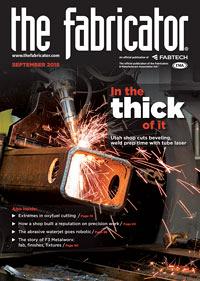Principal
- FMA
- The Fabricator
- FABTECH
- Canadian Metalworking
Categories
- Additive Manufacturing
- Aluminum Welding
- Arc Welding
- Assembly and Joining
- Automation and Robotics
- Bending and Forming
- Consumables
- Cutting and Weld Prep
- Electric Vehicles
- En Español
- Finishing
- Hydroforming
- Laser Cutting
- Laser Welding
- Machining
- Manufacturing Software
- Materials Handling
- Metals/Materials
- Oxyfuel Cutting
- Plasma Cutting
- Power Tools
- Punching and Other Holemaking
- Roll Forming
- Safety
- Sawing
- Shearing
- Shop Management
- Testing and Measuring
- Tube and Pipe Fabrication
- Tube and Pipe Production
- Waterjet Cutting
Industry Directory
Webcasts
Podcasts
FAB 40
Advertise
Subscribe
Account Login
Search
After the kaizen event
- By Jeff Sipes
- September 12, 2018
- Article
- Shop Management
Sipes continues his series on a hypothetical fabricator’s lean implementation. In May and June he detailed how a fabricator might start. In July he described how a fabricator might put together a project charter. In August, the team held a kaizen event. Sipes takes the story from here.
You spent the past four days conducting a kaizen event in weld frame assembly. The kaizen team seems engaged and excited. You might even say there was considerable pomp and circumstance, given the focus and support of the management team, the daily working lunches, the maintenance technicians and engineers on-call to respond, and the formal report-out meeting during which colleagues from the shop floor presented findings and results to senior management. The spotlight shone bright on the team.
But now what? Here comes the follow-up work. Some of this work comes after every kaizen event, but portions of it will depend on project specifics.
Project-specific Work
People go into the project expecting they will implement all their improvement ideas during the kaizen event. That’s the ideal, anyway, but usually not reality. No matter how focused the event is, team members probably can’t accomplish everything during the event itself. Considering this, they most likely end the event with a to-do list that might look something like this:
- Change the way jobs in frame assembly are planned. This requires minor modifications to the way the enterprise resource planning system processes orders.
- Upgrade a machine function. You need a technician from the equipment supplier to do this on-site, and one isn’t available for another two weeks.
- Paint a positioner in assembly to help error-proof the process. Visual cues on the positioner itself will help correct positioning and fixturing errors. It’s a simple solution, but it also couldn’t be done during the event, when production was running. You need production downtime for prepping, painting, and drying. You need a weekend.
The list goes on. Some tasks weren’t completed during the kaizen event because you needed more lead time to get parts from outside suppliers. Maintenance personnel and other technical resources weren’t available. Others required production downtime that just wasn’t possible during the event. For some tasks, you simply ran out of time.
Hence the need for a 30-day action plan, a vehicle to keep all these to-do items visible and create accountability. Team members present this plan to management during the report-out meeting.
The kaizen team members ensure that the action plan is executed. This does not mean that they do all the work. Rather, the action plan gives single-point accountability for each line item, telling everyone what needs to get done and who is responsible. The team meets weekly over the next 30 days to review the status and call for help if needed.
General Follow-up Work
Considering the project’s scope, some people who were not on the kaizen team will be affected by changes set in motion during the event. But not to worry. Kaizen team members received training. As a result, they know they must exhibit two fundamental traits: They must treat people with respect and demonstrate humility. People on the kaizen team do not have a monopoly on all good improvement ideas. They must consider who is affected, how they are affected, and ways to minimize disruption. They should also be very attentive in sharing what the changes are, why changes were made, and how those changes will be implemented.
At the same time, area supervisors and leaders need to take ownership. These people will support those working to implement the improved processes. You can’t expect improvement to be sustained if supervisors and leaders aren’t on board or are just going through the motions.
Supervisors and leaders aren’t in the dark either. They spent time with the kaizen team during the event, to help them understand the intricacies of the specific operation in question. After the event, someone from the kaizen team follows up one-on-one with area leaders to observe the changes and listen for and respond to feedback. Supervisors and leaders will own the process going forward.
In the world of metrics, you get what you measure. This is a very butchered version of what Lord Kelvin said way back in 1883. It was true then. It is true now. And it is especially true for kaizen events. If the process is not measured, then how can you know if you are improving, sustaining, or backsliding?
The relevant metrics have already been established during the kaizen event. During the follow-up, everyone needs to make sure the metrics continue to be understood and used. Effective metrics will drive desired behavior, and continually monitoring them is essential for measuring the status of improvement and to make sure you do not backslide.
Although the kaizen team came up with and implemented great improvement ideas, everyone should recognize that there is an expectation for continuous improvement. It never stops. Everyone needs to keep making it better. The kaizen event got things started. The team will lead by example during the 30-day action plan period, after which they will hand off a vibrant and continually improving process to the people who now own it.
Everyday Kaizen
Let’s be very clear: The kaizen event is not the be-all-end-all solution to every problem or opportunity. It is one of several approaches to improve a process in a focused and targeted way.
The kaizen event is a great way to get visibility and traction, especially during the early stages of a lean initiative. You can demonstrate that something different is happening. As you mature in your lean journey, you’ll rely on the formal kaizen event to address difficult issues that require extra attention, focus, or breakthrough-thinking.
As powerful as the kaizen event is, it paves the way for something even more powerful—everyday kaizen. This kind of improvement does not need the pomp and circumstance of a formal kaizen event. It shows up in many small improvements every day.
This is when everyone, from top floor to shop floor, understands the basics of lean, sees the waste in processes, understands flow, and is empowered to make many small improvements every day. Kaizen is more than a singular event. In a truly sustained lean manufacturing initiative, it’s a stepping stone to everyday kaizen.
Jeff Sipes is principal of Back2Basics LLC, 317-439-7960, www.back2basics-lean.com. If you have improvement ideas you’d like to read about, email him at jwsipes@back2basics-lean.com or Senior Editor Tim Heston at timh@thefabricator.com.
Four Elements of a Successful Kaizen Event
- Define the problem or opportunity. Ensure that you and your management team understand why it makes business sense to invest time and resources to improve. Clarify why it makes sense to use the formal kaizen-event approach rather than another approach.
- Write the project charter. This clearly defines the project scope, who will be involved and to what extent, and the expected outcomes. The charter is the primary document to communicate to the organization and to create alignment. It gets everyone on the same page.
- Conduct the event. Whether it runs over two days or five, the kaizen event will shine the spotlight on the project team. Give them room to work. Provide the resources they need. The event puts intense emphasis on implementing as many improvement ideas as possible.
- Follow up with a 30-day action plan. Some items probably will require follow-up after the kaizen event. The project-specific items should be scheduled and monitored for completion. Continue to support the kaizen team during this 30-day period to ensure results are achieved and people recognize the benefits.
About the Author

Jeff Sipes
9250 Eagle Meadow Dr.
Indianapolis, IN 46234
(317) 439-7960
subscribe now

The Fabricator is North America's leading magazine for the metal forming and fabricating industry. The magazine delivers the news, technical articles, and case histories that enable fabricators to do their jobs more efficiently. The Fabricator has served the industry since 1970.
start your free subscription- Stay connected from anywhere

Easily access valuable industry resources now with full access to the digital edition of The Fabricator.

Easily access valuable industry resources now with full access to the digital edition of The Welder.

Easily access valuable industry resources now with full access to the digital edition of The Tube and Pipe Journal.
- Podcasting
- Podcast:
- The Fabricator Podcast
- Published:
- 05/07/2024
- Running Time:
- 67:38
Patrick Brunken, VP of Addison Machine Engineering, joins The Fabricator Podcast to talk about the tube and pipe...
- Trending Articles
White House considers China tariff increases on materials

A deep dive into a bleeding-edge automation strategy in metal fabrication

A visit to Automate 2024 reveals the future might be now

Majestic Steel Arkansas fully operational

Rivian to expand Illinois facility to manufacture midsized SUV

- Industry Events
Laser Welding Certificate Course
- May 7 - August 6, 2024
- Farmington Hills, IL
World-Class Roll Forming Workshop
- June 5 - 6, 2024
- Louisville, KY
Advanced Laser Application Workshop
- June 25 - 27, 2024
- Novi, MI
Precision Press Brake Certificate Course
- July 31 - August 1, 2024
- Elgin,


























